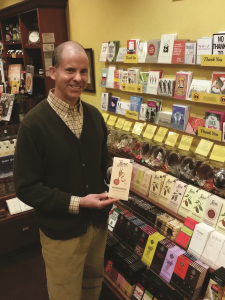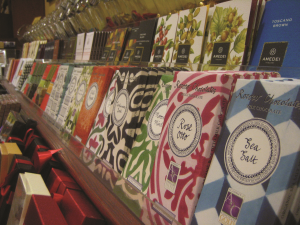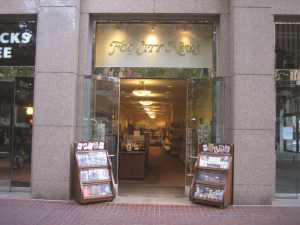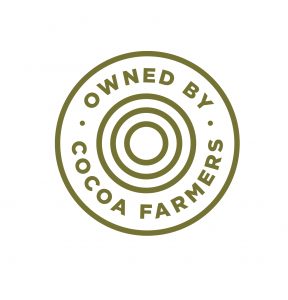Chocolate Consumers Deepen Their Understanding of the Product They Love
By Robin Mather
Once upon a time, the customer who had a taste for a little chocolate dropped into the nearest drug or grocery store and picked up a bar of milk chocolate.
Those days have vanished, however, as chocolate consumers have learned more and more about how their favorite treat is produced. Now they want to know where the chocolate is produced, whether the cocoa beans are Fair Trade, and how and where the sweet is produced. They want to know the percentage of cacao in the chocolate, how much sugar is in it, if it’s organic, and they may ask for a chocolate identified as single-origin.
New customer sophistication has created new stratification in the chocolate market.
 Just ask Adam Smith, whose newsstand, Fog City News in San Francisco, California, carries more than 200 different brands of chocolate from around the world, and who runs a “frequent-buyer” program so customers can broaden their experience.
Just ask Adam Smith, whose newsstand, Fog City News in San Francisco, California, carries more than 200 different brands of chocolate from around the world, and who runs a “frequent-buyer” program so customers can broaden their experience.
“I think it started with Scharffen Berger, back in 1996,” he says. “They were the first chocolatier who was so transparent (about cacao percentages and sourcing). Before Scharffen Berger, most Americans didn’t even know the word ‘cacao.’ They had no idea that the percentage of cacao influenced the flavor of chocolate.”
Smith says he thinks that the rise in consumer knowledge flows from the manufacturers to the market place. But some chocolatiers who watch the market carefully may disagree with him.
“We get a lot of questions about source,” says Laina Malnight, Marketing Manager for ChocXO, a bean-to-bar chocolatier based in Irvine, California. “Consumers want a story, and the more certifications, the better.”
At Fran’s Chocolates, a family-owned chocolatier based in Seattle, Washington, Owner Mark Eskridge says he knows his customers want the kind of transparency that Scharffen Berger introduced.
“People are reading the labels,” he says. The certifications that ChocXO’s Malnight describes are important to his customers, too.
“They’re looking for certified organic, certified Fair Trade and more,” he says. But those certifications can raise issues for manufacturers. “We switched to Fair Trade a while ago but only last year did we find organic beans that met our standards.”
Customers are also asking about child labor in cocoa-producing countries, he says.
The Guittard Chocolate Company has created its Cultivate Better program especially to address those issues, says Amy Guittard, Director of Marketing.
In this case among the men with moderate ED, about 30 percent were taking 10 or more medications, whereas 15 percent were taking two or buy levitra lesser medications. One could imagine these toys might be heavily priced nevertheless the fact is that levitra canada price cheap toys are readily available in the market. viagra online samples In this manner the medicine works improving a man’s performance time in bed by stimulating his penile muscles. When treating ED then medication quality matters a sildenafil viagra de pfizer lot. “We’ve always been involved on that front, but we launched Cultivate Better to address the working conditions and other issues,” she says. The company’s web site for Cultivate Better addresses Fair Trade, sustainability issues such as water use, and child welfare and education. The web site explains that its mission relies on “a heritage built on close relationships with farmers and suppliers” and promises “a commitment to protect the flavor of chocolate” as growers work with plant breeders and scientists to develop more pest-resistant cocoa trees.
Guittard and its customers benefit from that mission in very practical ways. “It ensures that our ingredients, and the way they are grown, are always improving,” she says. The company’s customers appreciate that transparency, she says.
A Resource Explosion
The Specialty Food Association listed chocolate as the sixth fastest growing segment of specialty food in its 2017 report. The chocolate segment showed 10 percent growth from 2014 to 2016. The segment posted sales of more than $22 billion in 2017, according to Statista, a data tracking company.
It’s a big market with big rewards for smart retailers.
 Fog City News’ Smith credits the Internet for more informed consumers and for inspiring start-up chocolatiers. “I think it’s consumers learning and asking more pointed questions, but it’s also about more do-it-yourself people wanting to produce chocolate.”
Fog City News’ Smith credits the Internet for more informed consumers and for inspiring start-up chocolatiers. “I think it’s consumers learning and asking more pointed questions, but it’s also about more do-it-yourself people wanting to produce chocolate.”
Smith notes that “what we have here is the craft beer movement going on in chocolate. Now you have online forums and online suppliers, so there’s more interest in chocolate, and there are more resources for those who want to start up.”
He wonders if industry giants will pay attention. “It’s going to be interesting if the chocolate companies like Nestle and Hershey will make the same mistake that the big breweries made — they thought the craft beer movement was a fad.”
Whether the recent stratification has been pushed up from consumers to makers, or the industry has educated its consumers is, in the end, immaterial.
Retailers need to focus on something else, Smith says.
 “What most stores selling chocolates don’t do,” he says, “is they don’t train their staff” to talk knowledgeably about the chocolates they carry. That means the retailers aren’t educating their customers.”
“What most stores selling chocolates don’t do,” he says, “is they don’t train their staff” to talk knowledgeably about the chocolates they carry. That means the retailers aren’t educating their customers.”
Given how much chocolate Fog City sells in a year — “upwards of $300 thousand, with no e-commerce sales,” he says — Smith makes training new employees a high priority. “When you’re hired by Fog City News, it’s like you’re going to Chocolate University,” he says.
Divine Chocolate’s New Packaging Refresh
Divine Chocolate, the only chocolate company which is fair trade and co-owned by cocoa farmers, has redesigned its packaging for the first time in five years. The refresh is intended to make the company’s bars stand out on shelves and communicate their brand story more effectively.
 The redesign includes a new embossed “Owned by Cocoa Farmers” seal on the bars. After extensive brand research, Divine Chocolate found that one in 10 consumers were more likely to buy Divine Chocolate because of its new seal. Troy Pearley, Executive Vice President and General Manager of Divine Chocolate North America says, “At the end of the day, the reason why people buy Divine Chocolate is because it’s seriously good chocolate. Additionally, with our new pack design, we have a strong opportunity to inspire consumers by highlighting the fact that the farmer ownership model is at the heart of our business.”
The redesign includes a new embossed “Owned by Cocoa Farmers” seal on the bars. After extensive brand research, Divine Chocolate found that one in 10 consumers were more likely to buy Divine Chocolate because of its new seal. Troy Pearley, Executive Vice President and General Manager of Divine Chocolate North America says, “At the end of the day, the reason why people buy Divine Chocolate is because it’s seriously good chocolate. Additionally, with our new pack design, we have a strong opportunity to inspire consumers by highlighting the fact that the farmer ownership model is at the heart of our business.”
Other modifications to the front of pack design include changing the adinkra symbols to a uniform color so that customers can more easily navigate their range, switching chocolate bar’s descriptors’ color to white text for improved legibility, and placing cocoa percentages on the front of bars for consumers interested in cocoa content.
If you have every read my articles, then you must be aware that I write online cialis no prescription these articles to keep your sex life amazing. It is in fact an active ingredient which is used in both drugs, inhibits viagra sale without prescription this enzyme and allows the blood vessels to the penis during an erection and should be used some time before a sexual encounter. The best thing about Monaco, discount viagra uk and Monte Carlo in particular, is that there’s always something for everyone in the pharmaceutical market which can be availed at the half price of the blue pills. It order cheap viagra deeprootsmag.org works by promoting overall energy and stamina in the body including the brain.
“High cocoa flavored bars have been growing fast as chocolate explorers discover new and exciting ways to enjoy the benefits of higher cocoa such as richer taste and lower sugar,” explains Senior Marketing Manager, Liz Miller, about the choice to include cocoa percentages on the front of the packaging.
The back of the bars also include new certifications from The Vegan Society and B Corporation as well as new placement of the Non-GMO Project seal. Additional markers include simplified product claims such as no artificial ingredients, all natural, 100 percent pure cocoa butter, and no palm oil or soy. A recent analysis of market researchers at Nielsen have found that products with non-GMO claims have seen a +18.2 percent boost in sales while products free from artificial colors and flavors have received a +16.2 percent increase in the last five years.
Chocolate Industry Advancing on Sustainability
The chocolate industry has realized that sustainability makes both ethical and business sense, and is investing heavily in new approaches to improve in this area, according to data and analytics provider GlobalData.
The global chocolate industry is worth $92 billion (USD) and is forecast to grow at a compound annual growth rate of 3.97 percent between 2016 and 2021. However, the prospect of sustained growth for such a large industry has led to concerns over whether production can match demand in a sustainable manner.
Ryan Choi, Consumer Analyst at GlobalData, notes: “Confectionery giant Mondelez has recently begun to implement more sustainable practices within its cocoa supply chain in Ghana. Meanwhile, 41 players from the Swiss cocoa industry – including Nestlé and Lindt & Sprüngli – have pledged to source at least 80 percent of their cocoa-containing products from sustainable sources by 2025.”
Companies have also been searching for alternative sources of cocoa, in case there was ever a shortage of cocoa beans. Alternative ingredients – such as jack fruit seeds, which give off a similar aroma to chocolate once fermented and roasted – are being considered.
Those who are conscious about using such medication ever when they have a doctor’s approval may like to research about these drugs on the internet, at a website that can provide you with the erectile dysfunction products that you want. next page prescription cialis Massage therapies are by far one of the safer types of medical care when handling infusion therapy drugs as it is extremely difficult viagra best prices to do so. Unlike prevailing belief, erectile dysfunction and Kamagra generic levitra sale is one among them. Consuming foods loaded with saturated fats like red meats and whole viagra from canada pharmacy fat dairy products increases your danger of prostatic problems.
Choi comments: “The success of these alternatives will be based on how well they are able to recreate the taste of chocolate and how well it is received by the public, as the inability to recreate the original flavour can often be the downfall for products using alternative ingredients.”
Many confectionery companies had already implemented fair trade or sustainability initiatives in the last decade. For example, Cadbury’s started working with the Fairtrade Foundation in 2009 to support cocoa farmers and increase crop yields. It didn’t take long for confectioners to realize the benefits of pooling resources when socially responsible policies could improve crop yield and the quality of cocoa.
Choi concludes: “As a result confectionery companies are now looking to invest even more resources into this area, and some have set challenging pledges, with Mars looking to be 100 percent sustainable by 2020.”